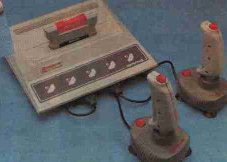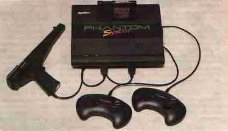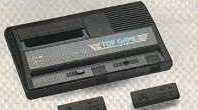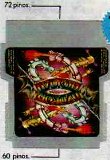The NES in Brazil You know all about the NES scene in the US, and maybe a little about the Famicom in Japan, but isn't there anything else? Although much of the world's video game stores are more havens of piracte multicarts than original creations, new treasures can still be found in the far reaches of Europe, Australia... and now Brazil, where the combination of official releases and creative piracy made a whole new parallel World Of Nintendo. Let's dive into the salsa-driven air and see what we can find... Special thanks to Marcelo Barboza for much of the information here. Genesis In the beginning there was the Sega Master System. This was released by 1989 by Tec Toy, which had an official license from Sega. As a result, there is essentially zero pirate SMS games or accessories in Brazil. Truly nutty Sega collectors know that Tec Toy released many SMS carts that either had graphics altered or were entirely new games only for the Brazil market. In 1992 they released Wonder Boy in Monster Land, changing the main character sprite to Monica, a popular Brazilian comic book character. This sold well enough that Tec Toy did the same thing with more US carts, and eventually started developing their own SMS carts, including Street Fighter II, Ren and Stimpy and Woody Woodpecker. These were all licensed creations, and Tec Toy kept the SMS business going all the way to 1997. From these completely legal, fully on the table dealings we now turn our heads to where the real action was... Dynacom and Gradiente While Tec Toy was pushing the Master System with a major marketing campaign, another company named Dynacom quitely released a console called "Dynavision 2" along with several carts.
The NES' fortunes took off with the Phantom System, released by the Brazilian company Gradiente. The System was praised by the video game magazines of the times for its sleek design, futuristic controllers (wait, they're Genesis controllers), and Lazer Tag-like light gun. As a result, Gradiente's system was (and still is) the most popular NES system in Brazil. The same company also released a dozen or so carts from 1990 on up. Most of these
Regardless of how they did it, Gradiente made a fair amount of money off of the Phantom System, and today are officially licensed by Nintendo to make SNES, N64 and Gameboy hardware and software. Gradiente did also release the real NES in 1995 as a budget console, but it disappeared quickly. CCE Atari 2600 collectors might know about CCE - they released a ton of pirate carts for the system. Within Brazil, CCE makes lots of low-quality electronics like TVs and CD players, and they have a reputation for cheap, crappy products that break down faster than your father's Pinto. CCE doesn't turn a blind eye to the passage of time, however - with the new decade joined the NES generation with the Top Game.
In a way it's pretty amazing when you think about it. Even in Hong Kong pirate manufacturers are usually at least a little coy about what they release, but in Brazil no concealment was really necessary - it's a part of the scene. Large-scale piracy was, and still is, a major part of the world of video games. Software To go along with all these clones, you'll naturally need some software to go with it. Brazil has no lack of NES games, from imports and pirates to one or two original productions. Many hardware manufacturers published carts along with whatever clone they were selling at the time. Most of these carts (indeed, most Brazil carts in general) are pirates, either multicarts or single games depending on the company. Dynacom's were mostly old stuff, the same 32k games that you see on many multicarts. CCE released their fair share of 60-pin pirates too, and a few of these are beginning to be discovered in North America. These carts run a wide range of genres, from Galaxian to Salamander and Castle Vania (their typo). The label art is original, but the games themselves are totally unchanged; Japanese title screens and in-game text is still all there. The titles of the games are unchanged too, departing from normal pirate tradition. However, whether deliberate or not, some titles have spelling errors in them.. titles like Double Drible and Circus Chablie are out there, and some multicarts have even named games after CCE's convention (Revolution Heroes instead of Guerrilla War, for example). Although there are only 20 or so titles, CCE released enough of these that they're among the easier Brazil games to find.
[ 1 | 2 | 3 | 4 | 5 | 6 | 7 | 8 | 9 | 10 ] With each system came more pirates, although there are several interesting exceptions. At one point a Portugese-translated version of Rambo was released by an unknown company. Ultimate League Soccer from AVE was converted by Milmar to Futebol, complete with teams from the Brazilian soccer league. Finally, Gradiente released several games from Taiwan companies like Bit Corp. that are difficult to find elsewhere, such as the light-gun police shooter Crime Busters.
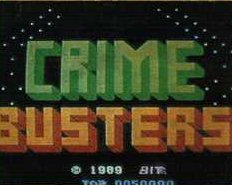 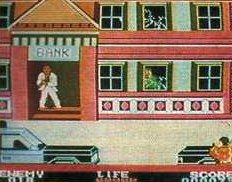 So - how many carts were released in Brazil? That's very hard to say - there were lots of companies in Brazil that did nothing but make and/or import pirate carts, and the sheer number of titles is huge as a result. Adding up all the American and Japanese imports, multicarts, odd single-game pirate hacks, and so on, you can easily get to several hundred titles easily. This stuff can still be found in Brazil today, but it can get pretty difficult for things other than the multicarts you can find worldwide. It's very hard even to attach a price to any of these things; due in part to the tumultuous Brazilian economy, consoles could be one price today and two or three times that the next day. Very generally, though, the semi-official carts were priced around $40 each. Multis and such today can be gotten for around $12, which is especially striking considering how expensive Nintendo's official products are in Brazil (the N64 console retailed for $650 upon release). In short, if you ever get the opportunity, Brazil has a great number of strange pirates and off-color variations, not to mention the great variety of clones that aren't available anyplace else. It's a great example of what can happen in a semi-pirate-ruled country: more creativity in illegal stuff and an exciting mixture of official (and non) hardware and software that bring out the collector freak in all of us.
Note: "Software" shows whether or not the hardware producer made any software of their own for the system.
|
